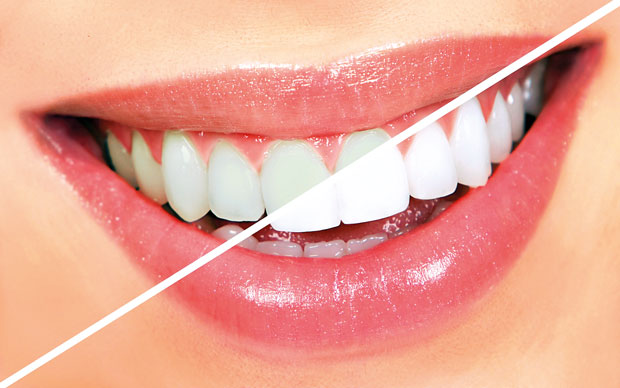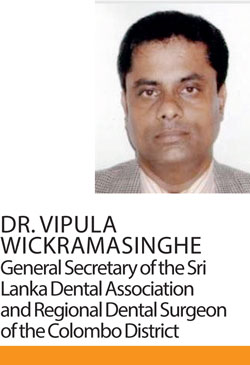01 Dec 2017 - {{hitsCtrl.values.hits}}

 Ever wanted that gleaming white picture perfect smile? But your teeth gradually losing its white colour may make you unable to break into that bright smile. The key in maintaining a proper white set of teeth is to follow dental and oral hygiene. But sometimes you may need extra help in achieving that perfect white teeth. That’s when you may consider approaching Teeth Whitening. But your head may be clouded with doubts and concerns regarding the whitening procedures. This week’s edition of the Health Capsule is ready to erase your doubts and answer questions regarding teeth whitening. We did this by consulting Dr. Vipula Wickramasinghe, General Secretary of the Sri Lanka Dental Association and Regional Dental Surgeon of the Colombo District. He provided a detailed explanation of the procedures, risks that may entail and maintenance that will help you better understand teeth whitening so you can make your choice. But it is important to keep in mind that teeth whitening is only done under approval and strict supervision of a dental surgeon.
Ever wanted that gleaming white picture perfect smile? But your teeth gradually losing its white colour may make you unable to break into that bright smile. The key in maintaining a proper white set of teeth is to follow dental and oral hygiene. But sometimes you may need extra help in achieving that perfect white teeth. That’s when you may consider approaching Teeth Whitening. But your head may be clouded with doubts and concerns regarding the whitening procedures. This week’s edition of the Health Capsule is ready to erase your doubts and answer questions regarding teeth whitening. We did this by consulting Dr. Vipula Wickramasinghe, General Secretary of the Sri Lanka Dental Association and Regional Dental Surgeon of the Colombo District. He provided a detailed explanation of the procedures, risks that may entail and maintenance that will help you better understand teeth whitening so you can make your choice. But it is important to keep in mind that teeth whitening is only done under approval and strict supervision of a dental surgeon.
Dr. Wickramasinghe explained that teeth whitening is either the restoration of a tooth to its natural shade or whitening beyond the natural shade. “Teeth whitening is purely a cosmetic type of treatment and not medicinal treatment. The patient is not really a patient,” he said.
Let’s return to square one where we consider the causes that lead to the discolouration of teeth. “Food habits such as the constant consumption of processed food and excessive drinking of alcohol can lead to discoloration of teeth. Dental and oral issues such as filling of enamel due to ageing, suffering from dry mouth (a condition where salivary glands don’t produce enough saliva to keep the mouth wet) and nerve fillings are also some causative factors. Some antibiotics, excessive intake of fluoridated water, as well as genetic factors can cause teeth to lose colour,” warned Dr. Wickramasinghe.
Treatment 
Teeth whitening is not child’s play. Dr. Wickramasinghe said that before a whitening treatment is confirmed, the dental surgeon will conduct a thorough investigation of the patient’s medical and dental health history, examining the patient through checkups to ensure that the health of the patient is satisfactory to undergo whitening. Once you are approved for the treatment, the dental surgeon will go over the whitening procedures explaining every detail. The patient will also be warned of the risks that may entail during and after the whitening procedure. Once the examinations and discussions have been made followed by the consent of the patient, only then will the whitening treatment be performed by the dental surgeon.
There are many teeth whitening techniques available. Most whitening techniques involve bleaching. “The bleaching agents used for teeth whitening are commonly hydrogen peroxide and carbamide peroxide. The enamel of the tooth is the outer hard surface. The dentine lies beneath the enamel. It’s a hard dense bony tissue forming the bulk of the tooth. The oxidizing agent (bleach) is used to penetrate the enamel into the dentine, breaking down the stain deposits from the dentine,” explained Dr. Wickramasinghe.
Home and office
Teeth whitening techniques are classified as office and home techniques. “Home techniques include methods that the patient can follow at home. Whitening chewing gums, whitening toothpastes, whitening rinses and whitening strips are some methods. Whitening strips are kept on the patient’s teeth overnight with bleaching material in between. There are also custom-made teeth whitening trays where a whitening gel can be applied and worn overnight,” he explicated. He also warned that home bleaching techniques are performed strictly under advice and supervision of dental surgeon. These materials cannot be purchased over the counter.
Office bleaching treatment is performed in the dental office by the dental surgeon. “Two trays compatible to the patient’s mouth will be inserted with a whitening gel and kept in the mouth for a given period of time for the bleaching action to be completed. The time may vary from patient to patient. It depends on the desired results and needs of the patient,” said the dental surgeon.
Light accelerated bleaching is another method, which follows the same procedure as mentioned above, but a light source such as a LED, will be used to activate and speedup the bleaching process, so that it can be completed in less time. “When nerve fillings are performed it can result in the discolouration of the tooth. For such a tooth, internal bleaching is available. The bleaching material will be inserted through the hole at the back of the nerve-filled tooth. The hole will then be closed for a certain period of time. Subsequently, the tooth’s colour will be checked with a colour code to confirm whether the tooth has reached the desired colour. If not, the process will be repeated until desired results are obtained,” he mentioned.
There are alternative methods instead of bleaching. One such method is called veneers. It’s a lamination of the discoloured tooth with a very small thin layer of white dental material or porcelain. A thin lamination of white material will be pasted on the tooth. Bleaching treatment won’t be very effective in cases where the teeth are severely discoloured. In this case, a white porcelain crown treatment should be approached.
Can you undergo teeth whitening?
Dr. Wickramasinghe strongly highlighted that there are particular patients for whom teeth whitening is strictly not recommended. Patients with; unrealistic expectations, allergies to bleaching agents such as hydrogen peroxide and carbamide peroxide, preexisting sensitive teeth, exposed dentine and those having taken drugs, patients with developmental defects in speech, those suffering from enamel corrosion, acid erosion and people who consume carbonated drinks and have gingival problems, tooth decay, abscesses, bad oral hygiene, loose teeth, severe gum diseases, pregnant and lactating mothers, children under the age of 16 and patients with visible white colour crown or fillings form the list.
Risky Boundaries
The dental surgeon stressed that people who are interested in teeth whitening should thoroughly understand the risks that may pursuit during and after the teeth whitening procedure. “These risks include hypersensitivity, irritation of gums and irritation of mucous membranes (lining of the mouth). There is a probability in uneven results of teeth shades after whitening. Teeth shades could also reverse back to the original status. Over bleaching (even when correct concentrations of bleaching agents are used, there are some instances where a case of over bleaching can occur in some patients),” cautioned Dr. Wickramasinghe.
Maintenance
Dr. Wickramasinghe stressed that maintenance after teeth whitening is important. “Brushing and rinsing after every meal is a must. Whitening rinses should be used daily along with flossing to prevent tartar accumulation. Maintenance has to be followed properly to secure whitening results for longer. Carbonated fizzy drinks, red wine, deeply coloured foods like certain toffees should be avoided,” he said. After office bleaching, repeated bleaching or touch ups to restore the shade of the tooth can be done.
Instead of considering the teeth whitening treatment, some may wonder how effective whitening toothpastes can be. “They are effective, but results do not reach the level of whitening treatments. The use of whitening toothpastes can lead to other problems when used long term. Whitening toothpaste is harder on the teeth than normal toothpaste, so it causes abrasion leading to tooth sensitivity,” the dental surgeon concluded.
23 Dec 2024 1 hours ago
23 Dec 2024 1 hours ago
23 Dec 2024 1 hours ago
23 Dec 2024 3 hours ago
23 Dec 2024 4 hours ago